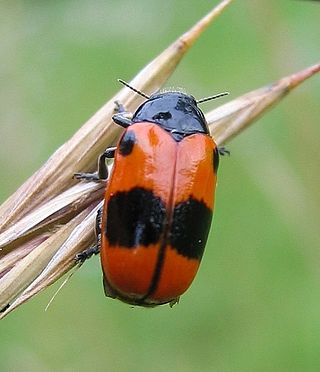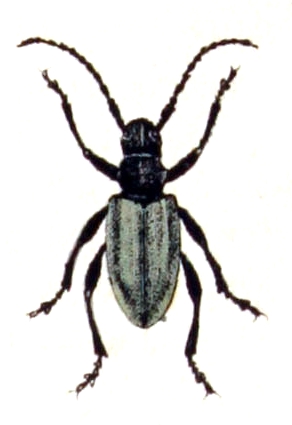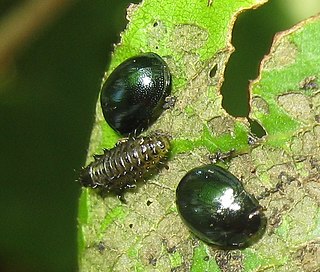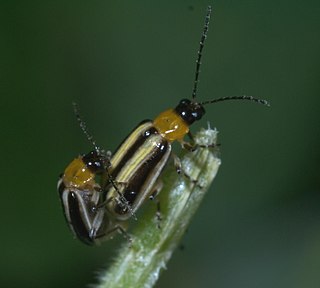Related Research Articles

The flea beetle is a small, jumping beetle of the leaf beetle family (Chrysomelidae), that makes up the tribe Alticini which is part of the subfamily Galerucinae. Historically the flea beetles were classified as their own subfamily.

The Clytrini are a tribe within the leaf beetle subfamily Cryptocephalinae, though historically they were often treated as a distinct subfamily, Clytrinae. As the other Cryptocephalinae, they belong to the group of case-bearing leaf beetles known as Camptosomata.

Monochamus is a genus of longhorn beetles found throughout the world. They are commonly known as sawyer beetles or sawyers, as their larvae bore into dead or dying trees, especially conifers such as pines. They are the type genus of the Monochamini, a tribe in the huge long-horned beetle subfamily Lamiinae, but typically included in the Lamiini today.

Endomychidae, or handsome fungus beetles, is a family of beetles with representatives found in all biogeographic realms. There are around 120 genera and 1300 species. The family was established based on the type genus Endomychus, a genus erected in 1795 by Panzer which was applied to a species that Linnaeus called Chrysomela coccinea. As the common name suggests, Endomychidae feed on fungi. Crowson, in his influential treatment of the beetles, placed the family within the Cucujoidea. They have a tarsal formal of 4-4-4 or 3-3-3 and the wings lack a closed radial cell. The second antennal segment has a sensory appendage that is as long as the third antennal segment. The family has also been grouped with the Coccinellidae in a group called the Trimera for having pseudotrimerous tarsi. A 2015 molecular phylogeny study found that the Cucujoidea were found to be non-monophyletic and the Endomychidae was refined with the removal of the Anamorphinae from within the family and elevated to the status of a full family, Anamorphidae. Mycetaeinae and Eupsilobiinae were also found not to belong within the clades of the core Endomychidae, and likewise reclassified into the families Mycetaeidae and Eupsilobiidae.

Nosodendridae is a family of beetles, with only 67 species in three extant genera, which are found worldwide. Nosodendron, the largest genus, is found in forests and attracted to yeast generated slime on the wounds of trees, and likely consumes fermented substances as well as fungi and microorganisms. Several additional genera and species are known from the fossil record. Nosodendridae is considered to be an isolated lineage within Polyphaga, being the sister group to the clade containing Staphyliniformia, Bostrichoidea and Cucujiformia.

Lebia is a genus of predatory ground beetles. Common names include colorful foliage ground beetles and flat ground beetles. They are found worldwide and there over 700 species in 17 subgenera.

Galerita is a genus of beetles in the family Carabidae, containing the following species:
Catapiesis is a genus of beetles in the family Carabidae, containing the following species:

Scaritinae is a subfamily of beetles in the family Carabidae, containing the following genera:

Clytini is a tribe of beetles in the subfamily Cerambycinae, containing the following genera:

Ceroplesis is a genus of flat-faced longhorn beetle in the subfamily Lamiinae of the family Cerambycidae.

Sphenophorus is a genus of weevils, often known as billbugs, in the family Curculionidae, and tribe Sphenophorini. Eleven species of billbugs infest managed turfgrass in North America.

Exophthalmus is a genus of broad-nosed weevils in the family Curculionidae. It contains 85 described species.
Aderpas is a tribe of longhorn beetles of the subfamily Lamiinae. It was described by Breuning and Téocchi in 1977. It is the only genus in the tribe, Aderpasini, and contains the following species:

Dorcadion is a genus of longhorn beetles of the subfamily Lamiinae.
Obereopsis is a genus of longhorn beetles of the subfamily Lamiinae, containing the following species:

Chrysomelini is a tribe of leaf beetles in the family Chrysomelidae. There are over 150 described genera in Chrysomelini, variously arranged into subtribes, though the exact number and constituency of these subtribes is a source of ongoing debate.

Saprininae is a subfamily of clown beetles in the family Histeridae. There are more than 50 genera and 800 described species in Saprininae.
Metachroma is a genus of leaf beetles in the subfamily Eumolpinae. It is distributed from Ontario, Canada to Mendoza, Argentina, including the Antilles. It has also been suggested that the genus extends to the Pacific Islands, though this is not confirmed. There are about 140 described species in Metachroma, 40 of which are found north of Mexico. An extinct species is also known from the Eocene of the United States.

Luperini is a tribe of skeletonizing leaf beetles in the family Chrysomelidae. There are more than 30 genera and 500 described species in Luperini.
References
- ↑ "Mesus Chevrolat, 1858". Global Biodiversity Information Facility. 2022. Retrieved 18 Dec 2022.